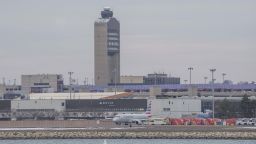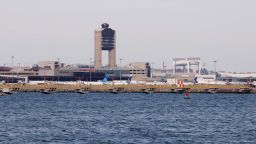The Federal Aviation Administration is investigating how close two commercial airliners came to colliding at Portland International Airport in Oregon during heavy rain last Monday.
Audio of the incident posted online includes an air traffic controller issuing urgent instructions to the crew of an Alaska Airlines flight, telling them to turn away from a nearby SkyWest flight.
“While attempting to land at Portland International Airport, the pilot of Alaska Airlines Flight 1299 initiated a go-around due to wind and turned towards SkyWest Airlines Flight 3978, which had just departed,” the FAA said in a statement. “An air traffic controller instructed the Alaska Airlines pilot to turn away from the SkyWest aircraft.”
Publicly available flight tracking data shows the flights were climbing out from parallel runways – the SkyWest flight had just taken off from Portland’s runway 28 Right while the Alaska Airlines flight had just attempted to land on runway 28 Left. Aviation weather reports from the time of the incident mention poor visibility and heavy rain.
The FAA says it will “determine the closest proximity between the aircraft” as part of its investigation.
Flight tracking site FlightAware shows the Alaska flight, which originally departed from John Wayne Airport in California, ultimately diverted to Roberts Field in Redmond, Oregon. The SkyWest flight landed in Seattle as planned.
CNN has reached out to the National Transportation Safety Board as well as Alaska Airlines and SkyWest for further comment.
A series of near collisions prompts investments in safety
After a decline in travel during the coronavirus pandemic, travelers have returned to the skies in significant numbers, and several reports of near collisions between commercial aircraft this year have raised concern among the public and prompted officials to address safety issues.
In March, Secretary of Transportation Pete Buttigieg called on industry officials to help address the root causes of the problem. “It would be one thing if we found a certain piece of technology in the cockpit or a certain control tower where there were a lot of issues,” Buttigieg told CNN. “But instead, what we’re finding is that pilots, ground crews and controllers alike seem to be experiencing this uptick. Some have described it as a kind of rust.”
“We’re not going to wait for something still worse to happen to act now,” he added.
Shortly after Buttigieg’s statement, the FAA’s Air Traffic Organization issued a memo laying out steps that should be taken to avoid more close calls.
“There is no question that we are seeing too many close calls,” the memo from the organization’s Chief Operating Officer Tim Arel said.
The FAA has since initiated safety reviews, increased air traffic control training and announced funding airport construction projects to address the issue.
The agency established the National Airspace System Safety Review Team in April, tasked with examining the air traffic system and delivering recommendations on how to enhance safety. In June, the FAA announced thousands of its air traffic controllers would be required to attend new monthly trainings.
The agency also announced $100 million in funding to reduce close calls at a dozen airports across the nation by reconfiguring taxiways, increasing lighting and more. It recently announced $121 million in additional funding for similar efforts at eight airports from Florida to Alaska.
CNN’s Greg Wallace contributed to this report.






